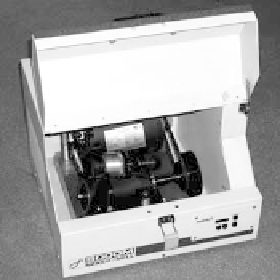Biomedical Engineering Reference
In-Depth Information
ball mills has been developed for different purposes including tumbler
mills, attrition mills, shaker mills, vibratory mills, planetary mills, etc.
For example, high-energy milling forces can be obtained using high
frequencies and small amplitudes of vibration. Shaker mills (e.g.,
SPEX model 8000) which are preferable for small batches of powder
(approximately 5-7 grams are suficient for research purposes) are
highly energetic and reactions can take place one order of magnitude
faster than with other types of mill. Since the kinetic energy of the
balls is a function of their mass and velocity, dense materials (steel or
tungsten carbide) are preferable to ceramic balls.
Figure 4.2 shows the SPEX Model 8,000 high-energy mill
manufactured by the CertiPrep Company (Metuchen, NJ, USA). The
vials (Fig. 4.3) are made of hardened ferritic steel, but vials made of
zirconia, alumina, agate, and hard-metal tungsten carbide are also
used to greatly limit contamination by grinding media, mainly iron
[44]. The milling that yields nanometric structure takes place about
10 times faster in a SPEX ball mill than in a planetary ball mill. The
milling time needed to produce ine powders and nanostructure
depends obviously on the nature of material, but also on other
parameters, such as the weight of the milling balls and the ratio of
the weight of balls to the weight of powder (BPR). The ball to powder
weight ratio can vary from 1 to 100. The time needed for milling to
the same ines of a powder usually decreases with the increase in the
BPR. Agglomeration and cold welding of metal particulates to the
reactor wall and the milling balls or to form balls
made of the milled
powder itself are common phenomena that occur during milling of
pure ductile metals in vials illed with inert gas, such as argon.
Figure 4.2
SPEX ball mill.

















